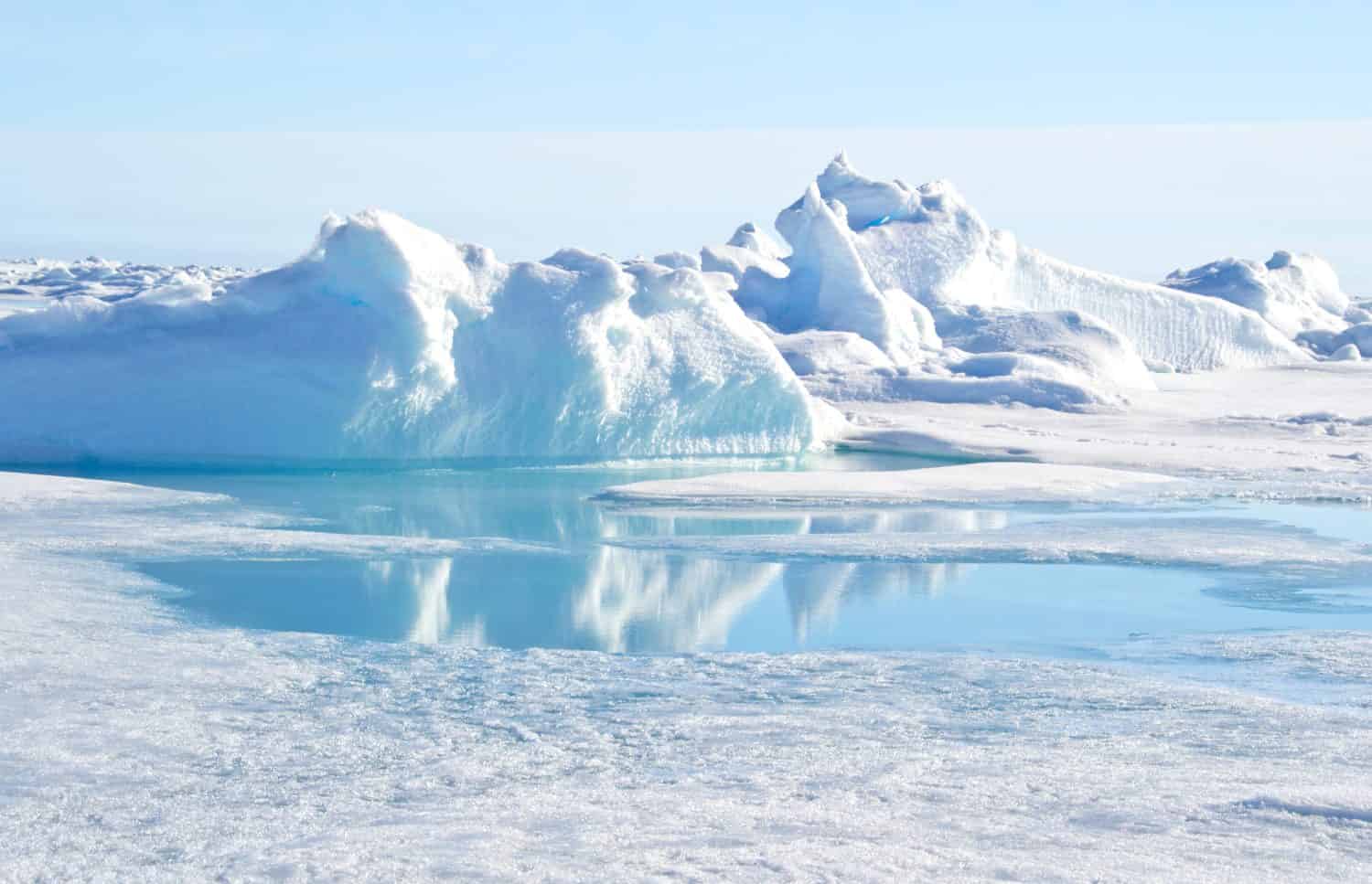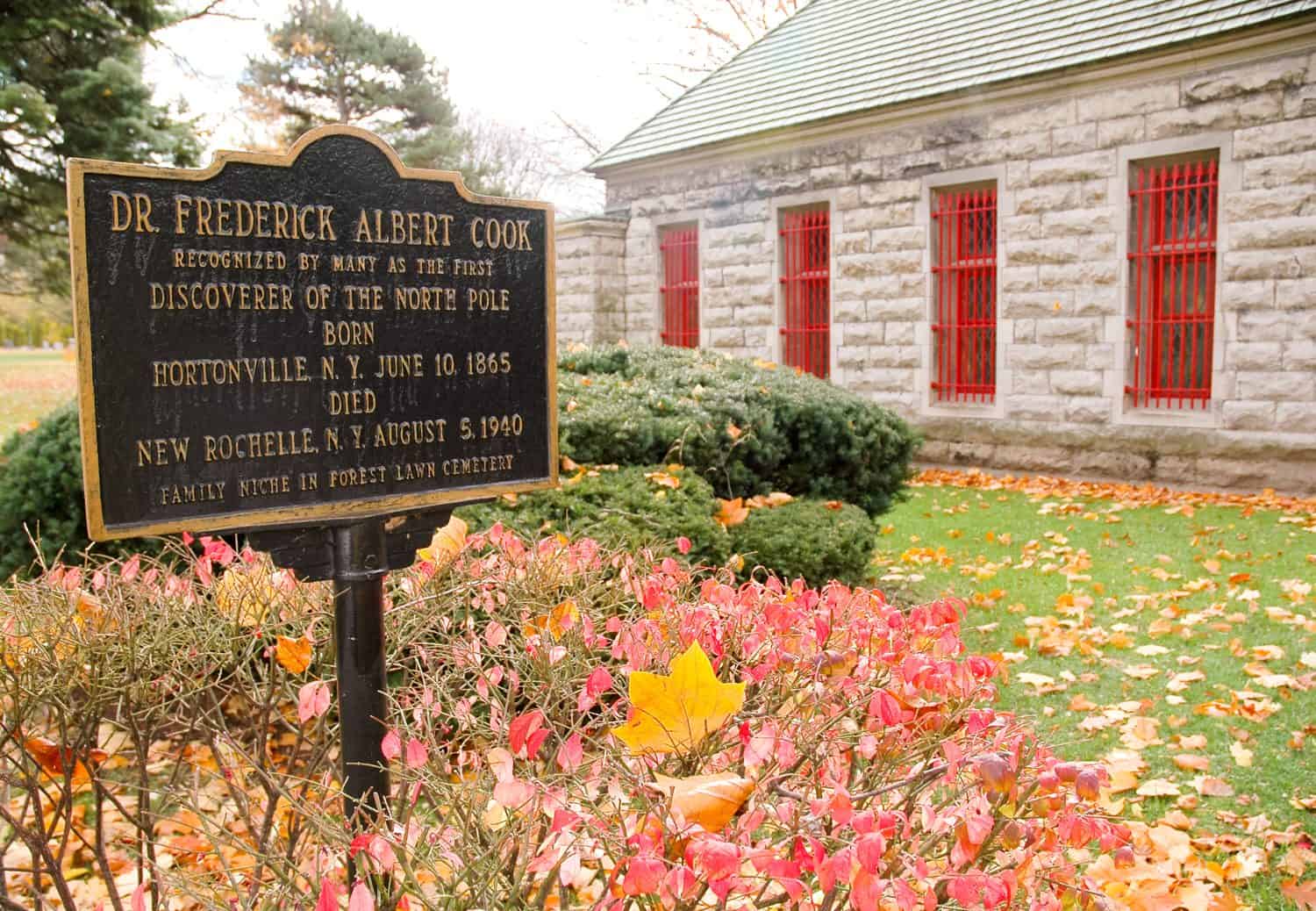The North Pole is the northernmost point on the planet with a latitude of 90 degrees north. It intersects with all lines of longitude. Above it, the North Star acts as the North Pole’s celestial guide. The sea here has 6-10-foot-thick ice and is more than 13,000 feet deep. Nunavut, a Canadian territory, lies closest to it. Greenland, the world’s largest island and territory of Denmark, is also nearby.
Warmer than the South Pole, it is right at the freezing point of 32 degrees Fahrenheit, 0 degrees Celsius. In fact, it has only one sunrise during the March equinox and one sunset during the September equinox. This unpredictable environment is not inviting for land creatures, although an occasional polar bear will wander into the area in search of food. Sealife here includes shrimp, arctic cod, sea anemones, and ringed seals. Arctic tern, snow bunting, and kittiwakes migrate here. Continue reading to discover the first people to reach and discover the North Pole.
The Beginnings of Recorded Exploration

The draw to discover the North Pole was strong.
©Christopher Wood/Shutterstock.com
Non-indigenous people began exploring this region in the 19th century. The first expedition to the North Pole was led by British Admiral Edward Parry in 1827. After this, Hjalmar Johansen and Fridtjof Nansen of Norway attempted an expedition in 1895. And two years later Salomon August Andree of Sweden attempted to fly over the North Pole in a hydrogen balloon. The draw to discover the North Pole was strong. It was one of the last frontiers left to explore. Many tried from many nations for over 300 years.
One succeeded in April 1909. American explorer Robert Peary sent word from Indian Harbour, Labrador that he had reached the pole. But a week earlier The New York Herald reported that American explorer Dr. Frederick Albert Cook claimed to have reached it in April 1908. The North Pole could only be discovered once, so who did?
The two men were friends, Cook joined Peary’s expedition to Greenland in 1891. Differences arose between them. In 1893 Cook left an arctic journey because Peary prohibited any expedition member from publishing anything before him. Peary wanted all the glory. However, both men continued to explore the region albeit separately.
Dr. Cook’s Expedition

Recognition of Dr. Frederick Albert Cook’s North Pole expedition.
©Zack Frank/Shutterstock.com
Cook chronicled his exploration in the book My Attainment of the Pole. He and his team departed in a schooner from Gloucester, MA in July 1907 for northern Greenland. Once there he established camp and left for the pole in February 1908 with nine natives, 11 sledges pulled by 103 dogs. He planned to follow the route created by Norwegian Otto Sverdrup who led a mapping party between 1898-1902.
The further north they ventured the smaller the team became which was the plan. Cook had two native hunters remaining. They traveled an average of 15 miles a day over 24 days. He described the frozen polar sea as being in constant motion, a flat-topped ice island higher and thicker than the ocean’s surrounding ice. At noon on April 21, 1908, he determined they were “at a spot as near as possible” to the North Pole. He and his men stayed there for two days leaving proof of his discovery in a brass tube buried on a crevasse.
On the Way Home
Assuming they were drifting eastward, they instead discovered a westerly drift that carried the party 100 miles west of their planned route where their supplies were. The men hunkered down for four months in a cave on Devon Island south of Ellesmere Island. The ice had cracked and there were open sections of the sea. They hunted with spears after running out of bullets. In February 1909 the ice and weather improved enough to allow them to walk across Smith Sound to Annoatok where they arrived starved and wearing tattered rags of fur in April 1909. It had been 14 months since they had set out on their expedition.
Many believed Cook had died on his journey, stated American sportsman Harry Whitney whom he met on Annoatok. Cook soon learned that Peary had left from a camp south of them eight months earlier in August 1908. They seemed to be on the same journey.
Robert Peary’s Expedition
Peary’s team consisted of 50 men, as many sledges, and 246 dogs. They traveled 280 miles in one month, averaging 13 miles a day. Everyone except for four natives and Matthew Henson, a previous team member from Maryland, was sent back when they were 134 miles from the pole. In April 1909 Henson “felt” they had reached the pole, he didn’t know how to read a sextant. Peary stuck an American flag atop the igloo they had constructed. The next day Peary put a strip of the flag and a note into a tin and buried it in the ice. They then returned home.
Meanwhile…
While Cook recovered in Annoatok, he planned a trip to Upernavik to catch a ship to Copenhagen and then to New York declining passage on a chartered vessel from Whitney. His native teammates returned to their village. He left Annoatok the third week of April 1909 arriving in Upernavik a month later where he shared his discovery.
In early August of that same year, he boarded the Hans Egede to New York telling passengers and crew all about his journey. The captain knew the value of his claim and made a stop at Lerwick in the Shetland Islands to telegraph the news. It was here that Cook wired the New York Herald, “Reached North Pole April 21, 1908,” and promised to leave a 2,000-word story with the Danish consul at Lerwick. The next day the headline read, “Discovered by Dr. Frederick A. Cook.”
The Natives Share Cook’s Discovery with Peary…
Locals on Annoatok shared the story about Cook and the two natives with Peary’s men. Whitney boarded Peary’s ship as his ship never arrived and told Peary about Cook’s expedition. Peary had Cook’s native team members questioned. Later on, they told Whitney they did not understand the questions or the papers they were told to mark. Peary did not allow any of Cook’s possessions aboard his ship according to Whitney who had Cook’s records and instruments from the journey. He left them among the rocks near the shoreline.
Peary’s ship stopped at Cape York in northwest Greenland, a note awaited him there telling him that Cook was en route to Copenhagen to announce his discovery of the North Pole on April 21, 1908. As a result, an angry Peary went full speed to the nearest wireless station which was 1,500 miles away at Indian Harbour, Labrador where he wired the New York Times regarding his discovery and the flag and tin he left at the pole.
Peary arrived in Nova Scotia on September 21 and then traveled on to Maine. Here he met with financiers of his expedition to create a strategy to undermine Cook’s claim. One of the investors gave the Bar Harbor Press a quote on Peary’s behalf regarding the submission or lack of Cook’s proof.
Cook Arrives in New York on the Same Day
On September 21, Cook arrives to cheers of people lining the streets where he greets them with, “I have come from the Pole.” He tells reporters his instruments are en route to New York to verify his claim. But unbeknownst to him, Whitney left them on the shores of Annoatok. He receives a wire from Whitney telling him Peary would not allow Cook’s possessions onboard his ship. Cook realizes what this means, but continues to give interviews. Meanwhile Peary tells the AP that he will wait for Cook to “issue a complete authorized version of his journey” before making his own story public.
The Battle Ensues
Peary mounted a campaign to discredit Cook’s reputation on previous expeditions. He released the signed transcript of Cook’s native team who stated they traveled a short time on the ice cap marking a map. Peary had colleagues and friends verify his story. In fact, Peary’s records were reviewed by his associates, who decided in his favor.
In 1910 Whitney returned to Greenland to search for Cook’s records and instruments to no avail. Between 1914 and 1915 members of Congress tried to discover the first people to reach and discover the North Pole. Alas, with the approach of World War I their efforts were lost.
In the End
Peary never spoke of his polar expedition after a 1911 Naval Affairs Subcommittee in the US House of Representatives. They reviewed his expedition diary and accepted his word, but doubted his proof, voting 4-3 in favor of him. He died of pernicious anemia, on February 20, 1920, at the age of 63.
Cook was sentenced to 14 years and nine months in prison in 1923 for mail fraud. By this time his reputation was tarnished. However, in 1930 he was paroled. President Franklin D. Roosevelt pardoned him a few months before he died of complications from a stroke, on August 5, 1940, at the age of 75.
Peary’s tin and Cook’s brass vial at the North Pole were never found. However, in 1968 Ralph Plaisted verified Cook’s descriptions of the polar sea. We hope we helped you to discover the first people to reach and discover the North Pole.
The photo featured at the top of this post is © iStock.com/1127470616
Thank you for reading! Have some feedback for us? Contact the AZ Animals editorial team.







